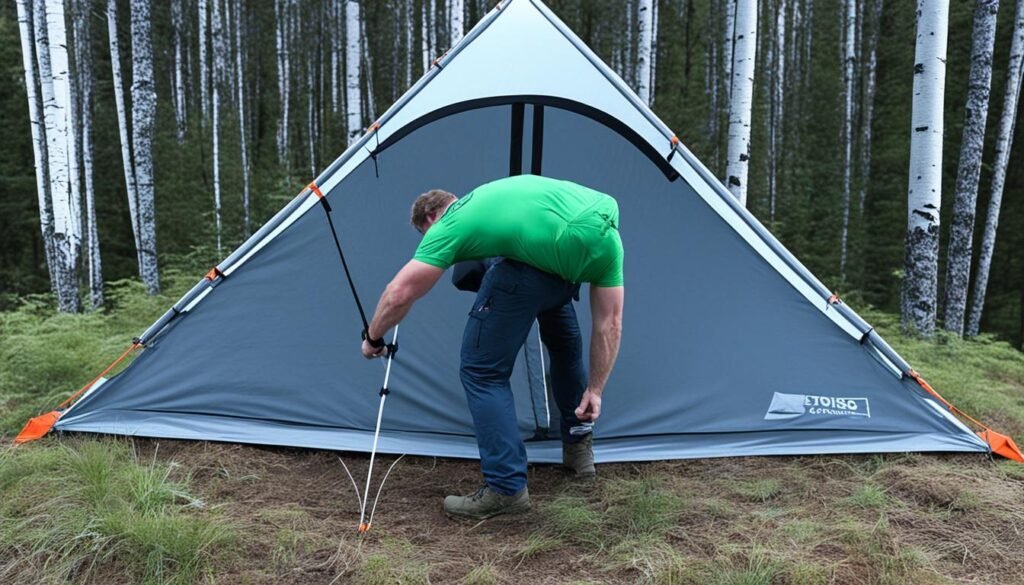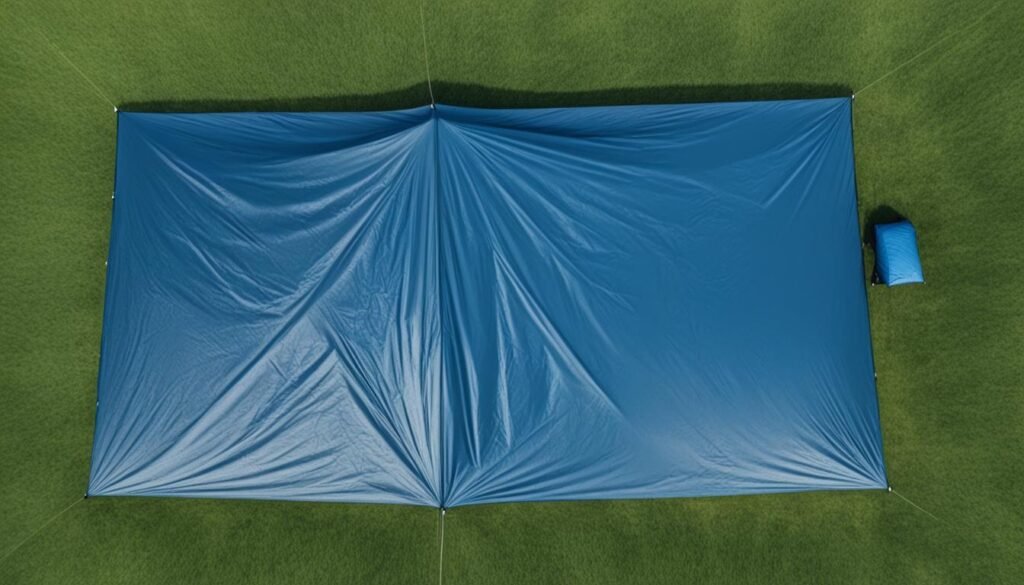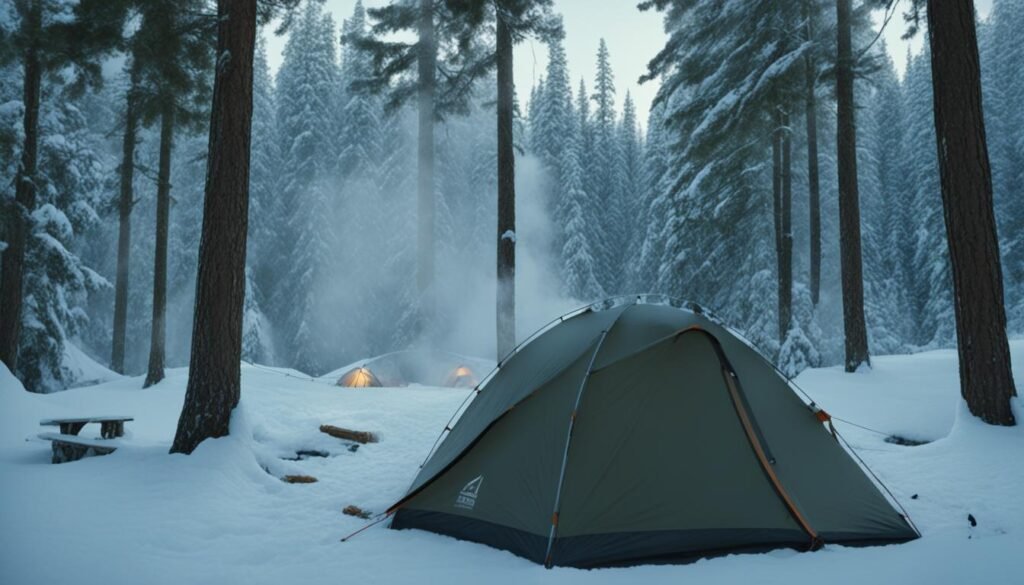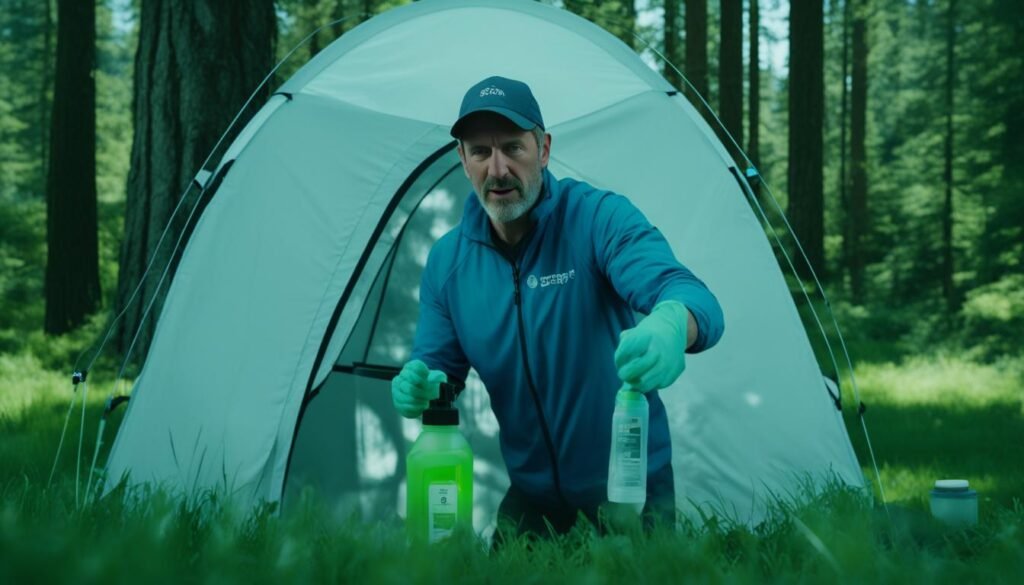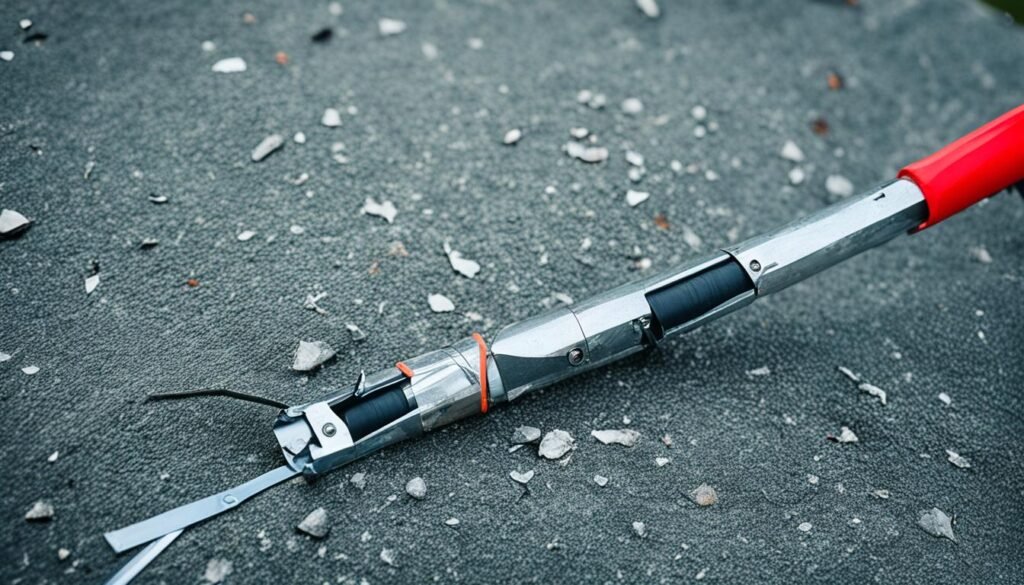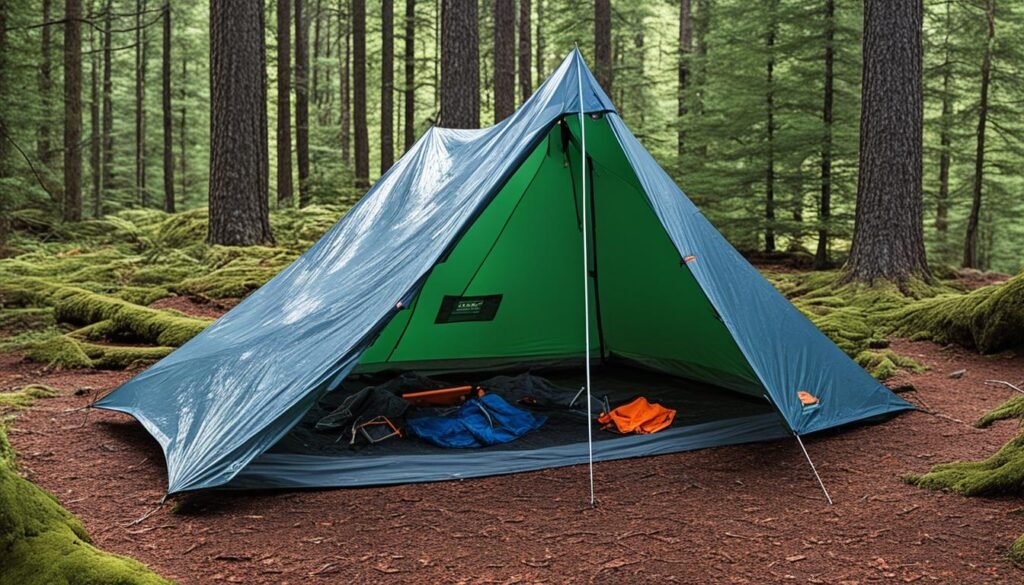Gearing up for your next outdoor adventure? Setting up a 12×12 tent may seem daunting, but with the right instructions and tools, it can be a breeze. Whether you’re a seasoned camper or a first-timer, this quick guide will walk you through the easy steps to assemble your 12×12 tent, offering tips and tricks to ensure a successful pitch. So, let’s get started on creating your home away from home in nature.
Key Takeaways:
- Follow the step-by-step setup instructions to efficiently pitch your 12×12 tent.
- Utilize tools such as hand trucks, dollies, tent jacks, tent stake drivers, and tent stake extractors to make the process easier.
- Understand the different types of large party tents available, such as easy up pop up tents, pole tents, and frame tents.
- Choose the right fabric that suits your needs, considering factors like fire resistance, water resistance, mildew resistance, and weight.
- Consider important tent features like sod cloth, eaves, eave socks, floor, fly, porch, and cook shack to add functionality and convenience to your setup.
Understanding Large Party Tents
Large party tents are versatile structures that provide ample space for hosting events, such as weddings, parties, and corporate gatherings. While they may appear intimidating due to their size and numerous components, setting up a large party tent doesn’t have to be a daunting task. With the right approach and tools, you can efficiently erect a tent that will create a comfortable and inviting space for your guests.
Unlike easy up pop up tents that can be assembled by a single person, large party tents such as pole tents and frame tents require the assistance of multiple individuals. This is because these tents are heavier and more complex, necessitating additional manpower to lift and secure them properly. However, by working collaboratively, you can ensure the safe and efficient setup of your large party tent.
To make the setup process easier and less physically demanding, consider utilizing tools like hand trucks and dollies. These equipment can help you transport the tent components with ease, minimizing the risk of strain or injuries. Additionally, using these tools allows you to work smarter, not harder, by reducing the physical exertion required during the setup process.
“Large party tents can seem overwhelming at first, but with proper planning and the right tools, they can be set up efficiently and safely. By working together and utilizing tools like hand trucks and dollies, you can make the setup process a breeze.”
By understanding how large party tents function and the importance of teamwork and appropriate tools, you can approach the setup process with confidence. This knowledge will not only streamline the assembly process but also help create a secure and well-structured tent that can withstand various weather conditions and provide a memorable experience for your event attendees.
Tools to Make Setup Easier
When it comes to setting up a large party tent, having the right tools can make a world of difference. Here are some essential tools that can make the setup process easier and more efficient:
1. Hand Trucks and Dollies
Moving heavy party tents can be a challenging task, especially when it comes to avoiding back injuries. That’s where hand trucks and dollies come in handy. These tools allow you to transport heavy tent components with ease, reducing physical strain and ensuring a safe setup process. Not only are hand trucks and dollies useful for setting up tents, but they can also be used for various household tasks.
2. Tent Jacks
Designed specifically for frame tents, tent jacks are a game-changer when it comes to setting up these types of tents. With a tent jack, one person can effortlessly lift and attach the tent top frame, eliminating the need for multiple people to hold the frame in place. This tool is a time-saver and can significantly simplify the setup process for frame tents.
3. Tent Stake Drivers
Driving tent stakes into the ground can be a labor-intensive task, but not with a tent stake driver. This tool automates the process, making it quicker and easier. Simply place the stake in the driver and let it do the work for you. Tent stake drivers save you time and energy, allowing you to focus on other aspects of the tent setup.
4. Tent Stake Extractors
When it’s time to take down the tent, removing the stakes from the ground can be tiresome and challenging. That’s where tent stake extractors come in handy. These tools simplify the process of pulling stakes out of the ground, reducing physical strain and preventing damage to the stakes. With a tent stake extractor, dismantling the tent becomes a breeze.
| Tool | Description |
|---|---|
| Hand Trucks and Dollies | Moving heavy tent components with ease, reducing physical strain and ensuring a safe setup process. |
| Tent Jacks | Specifically designed for frame tents, allowing one person to easily lift and attach the tent top frame. |
| Tent Stake Drivers | Automate the process of driving tent stakes into the ground, making it quicker and easier. |
| Tent Stake Extractors | Simplify the process of pulling stakes out of the ground, reducing physical strain and preventing damage to the stakes. |
These tools are invaluable for anyone setting up large party tents. By utilizing hand trucks, dollies, tent jacks, tent stake drivers, and tent stake extractors, you can make the setup process easier, more efficient, and less physically demanding.
Setting Up a Frame Tent
When it comes to setting up a frame tent, one of the biggest challenges is attaching the legs to the tent top frame while trying to keep it stable. This task typically requires multiple people to hold the frame and legs simultaneously, which can be quite cumbersome and time-consuming.
However, there is a handy tool that can simplify this process and make it a one-person job: the tent jack. A tent jack is specifically designed for frame tents and allows for easy hoisting and holding of the fully assembled tent top off the ground.
By utilizing a tent jack, you can securely lift the tent top frame and keep it in place while you attach the legs. This eliminates the need for additional people to help stabilize the frame, making the entire setup process significantly easier and more efficient.
With the tent jack, you can confidently set up your frame tent on your own, saving time and energy. It is a valuable tool that simplifies the process and ensures a smooth and successful setup.
Benefits of Using a Tent Jack:
- Simplifies the setup process for frame tents
- Allows for one-person setup
- Reduces the need for additional help
- Ensures stability and safety during the setup
If you’re planning to set up a frame tent, investing in a tent jack is highly recommended. It will make your tent assembly process much more manageable and efficient, allowing you to enjoy your outdoor event or camping trip with ease.
Simplifying Pole Tent Setup
When it comes to setting up pole tents, simplicity and efficiency are key. With just a few people, you can easily raise a pole tent and create a sturdy and reliable shelter for your outdoor event or camping trip. To further simplify the setup process, consider using tent stake drivers. These handy tools automate the task of driving tent stakes into the ground, making it faster and easier.
Pole tents are particularly useful when dealing with hard ground surfaces like frozen or asphalt areas. In such situations, driving tent stakes can be challenging and time-consuming. But with the help of tent stake drivers, you can power through the toughest grounds and securely anchor your tent.
Benefits of Tent Stake Drivers
Using tent stake drivers offers several advantages:
- Efficiency: Tent stake drivers automate the stake-driving process, reducing manual effort and saving time.
- Precision: These tools ensure proper and consistent stake placement, enhancing the overall stability and security of the tent.
- Easy operation: Tent stake drivers are designed to be user-friendly, with ergonomic handles and efficient mechanisms.
- Durable construction: High-quality stake drivers are built to withstand repeated use and challenging environments.
By incorporating tent stake drivers into your pole tent setup process, you can streamline the assembly and ensure a smooth and hassle-free experience. With minimal effort, you’ll have your pole tent securely erected and ready for use.
| Tent Stake Driver | Description |
|---|---|
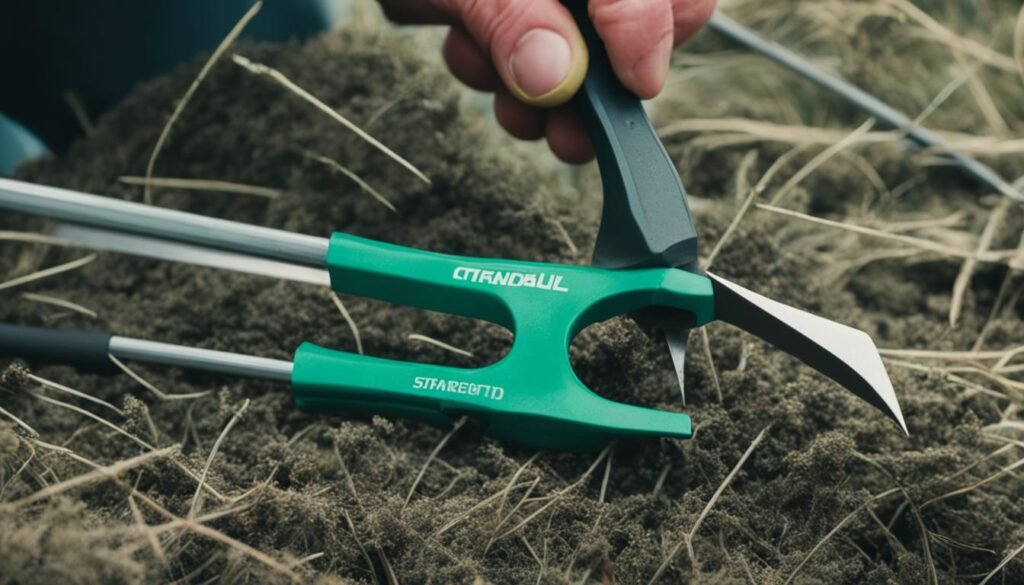 |
A heavy-duty tent stake driver with a non-slip grip handle for easy operation. Designed to withstand challenging ground conditions and provide efficient stake placement. |
Important Considerations for Tent Fabrics
When buying a tent, fire resistance, water resistance, and mildew resistance should be among your top considerations. These features ensure that your tent can withstand different weather conditions and maintain its durability over time. Additionally, the weight of the canvas and the finish of the fabric play a crucial role in the tent’s performance.
If you plan to use a heating unit inside the tent, it is important to ensure that the fabric is treated for fire resistance. This ensures the safety of everyone inside the tent and reduces the risk of accidents. Look for tents with fire-resistant fabric certifications.
Water resistance is essential to keep you dry during wet weather conditions. Look for tents with a water-resistant or waterproof fabric to ensure that moisture stays outside the tent. This will help prevent any water leakage, keeping you and your belongings dry.
In addition to fire and water resistance, it is crucial to consider a tent’s mildew resistance properties. Mildew can cause damage to the fabric and create an unpleasant smell. Look for tents made with mold and mildew-resistant materials to ensure longevity and maintain a fresh environment inside the tent.
The canvas weight also affects the performance and portability of the tent. Lightweight fabrics are easier to transport and set up, making them ideal for backpacking or hiking trips. On the other hand, heavier fabrics may offer more durability and stability, making them suitable for longer camping stays.
Some tents feature a paraffin finish. This heavy coating provides high levels of water, mildew, and fire resistance. However, it adds weight to the overall tent, making it less suitable for backpacking or hiking adventures.
Alternatively, Relite fabric can be a great choice for those looking for a lightweight option that meets all fire, water, and mildew requirements. Relite is a synthetic fabric that offers excellent performance while being lighter in weight compared to other materials. It provides a balance between durability, protection, and convenience during outdoor activities.
Benefits of Different Tent Fabrics:
| Feature | Paraffin Finish Fabric | Relite Fabric |
|---|---|---|
| Fire Resistance | ✓ | ✓ |
| Water Resistance | ✓ | ✓ |
| Mildew Resistance | ✓ | ✓ |
| Canvas Weight | Heavy | Lightweight |
Understanding the differences between tent fabrics and their features can help you make an informed decision when purchasing a tent. Consider the specific requirements of your outdoor adventure and choose a fabric that best suits your needs, whether it is for backpacking, camping, or other activities.
Important Tent Features
Tent features play a crucial role in enhancing functionality and convenience during your camping experience. Let’s explore some key tent features that you should consider:
- Sod Cloth: Acting as an air seal, the sod cloth prevents the tent from coming into direct contact with the ground, helping to keep it clean and protected.
- Eaves: Eaves provide additional coverage and stability to the tent structure, ensuring proper protection from the elements.
- Eave Socks: These handy openings located at the end of the eaves enable easy attachment of internal frames, allowing for added support and customization.
- Floor: Tents may have a sewn-in floor or a separate floor that can be staked down. It’s advisable to opt for a tent floor that features a cut out in the stove area for safe and convenient cooking.
- Fly: A fly, or rainfly, provides an extra layer of protection against heavy rains and snow, keeping the interior dry and shielding against condensation. It also helps insulate the roof area, reducing the buildup of moisture inside.
- Porches: Porches are extensions of the main tent, offering additional space for storage and relaxation. They are ideal for keeping muddy shoes or gear separate from the living area.
- Cook Shacks: Cook shacks provide a dedicated space for cooking, allowing you to prepare meals without interfering with the main tent area. They help keep the cooking process organized, efficient, and safe.
By considering these essential tent features, you can select a tent that suits your specific needs and enhances your camping experience.
Benefits of Using a Fly
A tent fly offers several benefits that enhance your camping experience. Whether you’re camping in the woods or attending an outdoor event, using a tent fly can provide added protection and convenience. Here are some key advantages:
Protection
The tent fly acts as a shield against various elements, safeguarding you and your belongings. It protects the tent from sparks, preventing accidental fires. Additionally, it offers protection against harmful UV rays, reducing the risk of sunburn and long-term skin damage. The tent fly also acts as a barrier against moisture, keeping you dry during rain showers and preventing water from seeping into the tent.
Condensation Reduction
Condensation inside the tent can be bothersome, causing discomfort and dampness. However, using a tent fly can help reduce condensation by insulating the roof area. The fly creates a barrier that separates the warm air inside the tent from the cooler air outside, reducing the chances of condensation forming on the tent walls and ceiling. This helps keep the inside of the tent dry and comfortable.
Easy Snow Removal
During winter camping trips, snow accumulation can be a challenge. However, with a tent fly, removing snow becomes easier. The fly creates a protective layer over the roof, making it simpler to brush off accumulated snow without having to clear the entire tent. This saves time and effort, allowing you to quickly enjoy the warmth and comfort of your shelter.
Using a tent fly is particularly beneficial if you plan to leave your tent set up for extended periods, as it provides continuous protection and helps maintain the integrity of the tent. Ensure that your tent fly is securely attached and properly tensioned to maximize its effectiveness.
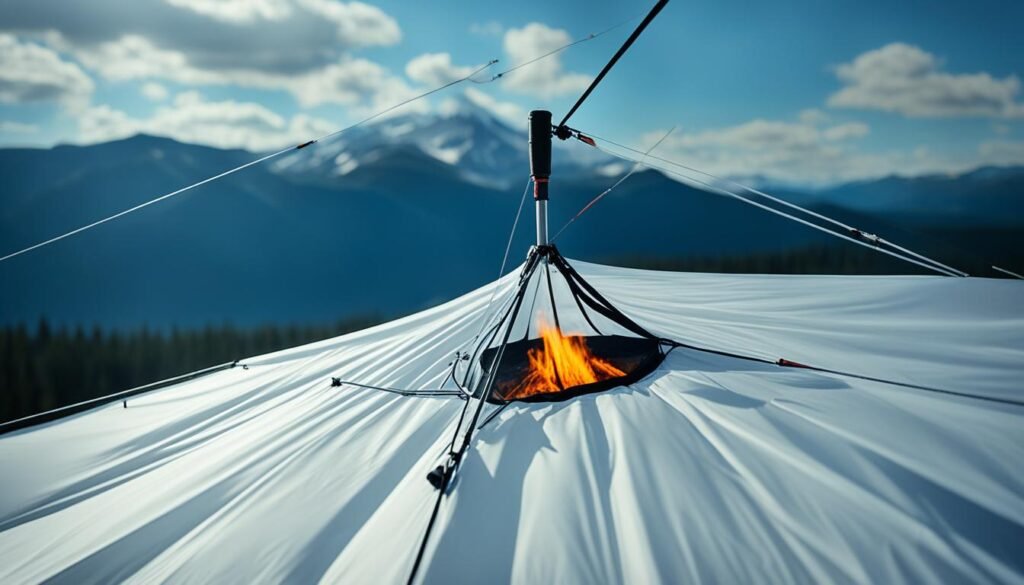
By utilizing a tent fly, you can enhance your camping experience by providing additional protection, reducing condensation, and simplifying snow removal. It’s a practical accessory that adds value to your camping gear.
Are Tent Footprints Necessary for Setting Up a 12×12 Tent?
Yes, using tent footprint techniques is necessary for setting up a 12×12 tent. A footprint creates a barrier between the ground and the bottom of the tent, preventing water seepage and providing extra protection. It also helps to keep the tent floor clean and increase its longevity.
Conclusion
Setting up a 12×12 tent can be a breeze if you follow step-by-step setup instructions and have the right party tent setup tools on hand. By working smarter, not harder, you can quickly and efficiently erect a large party tent and spend more time enjoying your outdoor adventure.
Step-by-Step Setup Instructions
Follow these easy steps to assemble your 12×12 tent:
- Read the manual carefully and familiarize yourself with the tent’s components.
- Choose a suitable location for your tent and clear the area of any debris.
- Start by laying out the tent fabric and connecting the poles or frame according to the instructions.
- Raise the tent by enlisting the help of others to secure the structure in place.
- Attach the tent stakes to secure the tent to the ground, ensuring it is properly tensioned.
- Complete the setup by attaching any additional features like the fly, porch, or cook shack.
Party Tent Setup Tools
Having the right tools can make the setup process even easier. Consider using the following tools:
- Hand trucks and dollies: These tools help move heavy tent components without straining your back.
- Tent jacks: Specifically designed for frame tents, these jacks make it possible for one person to lift and attach the tent top frame.
- Tent stake drivers and extractors: These tools automate the process of driving and extracting tent stakes, saving you time and effort.
Large Tent Setup Tips
Here are a few additional tips to make setting up a large tent a breeze:
Working together with a team can significantly speed up the setup process while ensuring safety.
Take your time to understand the different fabric options and the important features of your tent. This knowledge will help you select the right tent for your needs and make the setup process smoother.
With the right instructions, tools, and tips at your disposal, you’ll be able to erect a 12×12 tent confidently and efficiently. So go ahead and plan your next outdoor event knowing that you have the knowledge and tools to make the setup process a breeze.
As we continue our journey towards successfully erecting a 12×12 tent, here are some additional tips and tricks that can make the setup process more efficient and hassle-free.
1. Organize Your Tools
Before you start setting up your tent, take a moment to gather all your tools and keep them within reach. This will save you time and effort as you won’t have to search for them during the setup process.
2. Clear the Area
Ensure that the area where you plan to set up your tent is free from any debris, rocks, or sharp objects that could potentially damage the tent fabric or pose a safety hazard.
3. Follow the Instructions
Read the setup instructions provided with your tent carefully and follow them step by step. Each tent may have specific guidelines and recommendations that are crucial for proper assembly.
4. Work as a Team
Enlist the help of friends or family members to assist you during the tent setup. Having an extra set of hands not only makes the process faster but also ensures safety and prevents unnecessary strain.
5. Take Breaks
Setting up a large tent can be physically demanding, so it’s important to take short breaks to rest and hydrate. Pace yourself and listen to your body to avoid exhaustion or injury.
6. Practice Tent Setup
If you’re setting up the tent for the first time, consider doing a practice run in your backyard or a spacious area before your actual camping trip. This will familiarize you with the process and help you overcome any challenges.
With these helpful tips in mind, you’re now equipped with the knowledge and tools needed to efficiently set up your 12×12 tent. Let’s move on to the next section where we explore additional insights to further enhance your tent setup experience.
When setting up your 12×12 tent, it’s important to consider proper lighting. Illuminating your tent not only adds ambiance but also enhances safety and visibility during nighttime activities. Here are a few key factors to consider when selecting lighting options for your tent:
1. LED Lighting Solutions
LED lights are a popular choice for tent lighting due to their energy efficiency and long-lasting performance. These lights come in various forms, including string lights, lanterns, and portable LED panels, providing versatile lighting options for different campsite setups. LED lights are durable, lightweight, and produce bright, white light, creating a well-lit environment inside your tent.
2. Battery-Powered Options
Battery-powered lights offer convenience and flexibility, as they can be easily carried and set up anywhere within your tent. Opt for rechargeable batteries or invest in a portable power station to ensure a reliable power source throughout your camping trip. Battery-powered lighting options include lanterns, headlamps, and portable LED light bars, providing focused lighting for specific areas or overall illumination.
3. Hangable Lanterns
Hangable lanterns are a practical choice for tent lighting, as they can be suspended from the tent’s ceiling or hooks. These lanterns provide overhead illumination and can be adjusted for brightness levels. Look for lanterns with built-in hooks or handles for easy hanging and versatile lighting options.
4. Solar-Powered Solutions
If you prefer an eco-friendly lighting option, solar-powered lights are an excellent choice. These lights harness the sun’s energy during the day and automatically illuminate your tent at night. Solar-powered lanterns and string lights are easy to install and offer long-lasting performance without relying on batteries or electricity.
Proper lighting inside your tent not only creates a welcoming atmosphere but also enhances safety and visibility during nighttime activities.
To create a well-lit and comfortable environment, consider combining different lighting options based on your specific needs. Use string lights to add a cozy ambiance, lanterns for overall illumination, and headlamps for individual tasks or reading. Furthermore, make sure to position the lights strategically to minimize glare and maximize visibility within your tent.
By enhancing your tent setup with proper lighting, you can create a cozy and well-illuminated space for various camping activities. Whether you’re gathering around a campfire, playing games, or simply relaxing, having the right lighting will enhance your overall camping experience.
When it comes to selecting a tent for your outdoor adventure, the fabric plays a crucial role in determining its performance and durability. It’s important to choose a fabric that suits your specific needs and provides the desired level of protection. Here, I will discuss different tent fabrics and their key characteristics.
1. Fire Resistance
Fire resistance is a crucial factor to consider, especially if you plan to use a heating unit inside the tent. Some tent fabrics are treated with fire-resistant coatings, while others have inherent fire-resistant properties. Make sure to check the specifications and choose a fabric that meets the fire safety requirements for your intended use.
2. Water Resistance
Keeping dry during outdoor activities is essential, which is why water resistance is a key feature to look for in tent fabrics. Some fabrics are naturally water-resistant, while others are treated to enhance their water-repellent properties. Consider the expected weather conditions and choose a fabric that can withstand heavy rain and provide a dry interior.
3. Mildew Resistance
Mold and mildew can not only damage the fabric but also affect your health. Opting for a mildew-resistant tent fabric is important, especially if you plan to use the tent in humid or damp environments. Look for fabrics that are treated to inhibit the growth of mold and mildew, ensuring a clean and healthy camping experience.
4. Fabric Weight
The weight of the tent fabric can impact its portability and ease of setup. Heavier fabrics may provide superior durability, but they can be cumbersome to carry and set up. On the other hand, lighter fabrics are easier to handle but may sacrifice some durability. Consider your specific needs and preferences to strike the right balance between weight and durability.
5. Paraffin Finish
Some tent fabrics feature a paraffin finish, which provides additional protection against water, mildew, and fire. While the paraffin finish enhances the fabric’s performance, it also adds weight. Evaluate the trade-offs and choose a fabric with a paraffin finish if you prioritize enhanced protection.
6. Introducing Relite Fabric
Relite fabric is a popular synthetic tent fabric that offers a lightweight alternative with excellent fire, water, and mildew resistance. It provides the best of both worlds, ensuring durability and comfort without compromising on weight. Consider Relite fabric as a suitable option for your camping needs.
By understanding the different tent fabrics available and their specific features, you can make an informed decision when selecting a tent. Remember to consider factors such as fire resistance, water resistance, mildew resistance, fabric weight, and finish options in order to choose the right fabric for your outdoor adventures. Now, let’s move on to exploring important tent features in the next section.
Setting up a large party tent can be a daunting task, but with the right knowledge and tools, it doesn’t have to be. As an experienced tent enthusiast, I’ve gathered some expert tips to ensure a smooth and efficient setup process. Whether you’re preparing for a family camping trip or hosting an outdoor event, these tips will help you get your 12×12 tent up and ready in no time.
Gather Your Tools
Before you begin setting up your tent, make sure you have all the necessary tools at hand. Here are some essentials:
- A hand truck or dolly to help move heavy tent components without straining your back.
- A tent jack specifically designed for frame tents, which allows for easy lifting and attachment of the tent top frame.
- A tent stake driver to automate the process of driving tent stakes into the ground quickly and easily.
- A tent stake extractor to simplify the task of pulling stakes out of the ground.
Follow a Step-by-Step Guide
Having a detailed step-by-step guide is crucial for a successful tent setup. It will provide you with clear instructions and ensure you don’t miss any important steps. Remember to read the manual thoroughly before you begin. Here’s a simplified version of the setup process:
- Choose a suitable location for your tent and clear the area of any debris or obstacles.
- Lay out the tent fabric and unfold it, making sure it is taut and free of wrinkles.
- Attach the tent top frame to the legs using the tent jack for easy lifting and securing.
- Drive the tent stakes into the ground using the tent stake driver, ensuring the tent is securely anchored.
- Attach any additional features such as a porch or cook shack for added convenience.
- Double-check the stability and tautness of the tent, making any necessary adjustments.
Pay Attention to Fabric and Features
Understanding the type of fabric used for your tent and its features is essential in ensuring durability and functionality. Here are a few key considerations:
- Choose a tent fabric with fire resistance if you plan on using a heating unit inside the tent.
- Opt for a fabric that is water-resistant and mildew-resistant to protect against the elements.
- Consider the weight of the fabric, as heavier fabrics may offer more durability but can be more challenging to transport.
- Look for fabrics with a paraffin finish for added water, mildew, and fire resistance.
- Consider synthetic fabrics like Relite, which are lightweight and meet all fire, water, and mildew requirements.
- Take advantage of tent features such as sod cloth, eaves, floors, and flies to enhance comfort and convenience during your outdoor adventure.
Remember, choosing the right fabric and features for your tent can make all the difference in ensuring a comfortable and enjoyable experience.
By following these expert tips and utilizing the right tools, you’ll be well-prepared to tackle the setup of your 12×12 tent. With a little practice and attention to detail, you’ll quickly become a pro at assembling your large party tent. Happy tenting!
Conclusion
Erecting a 12×12 tent can be a breeze if you follow the step-by-step setup instructions and have the right tools at your disposal. By using essential party tent setup tools such as hand trucks, dollies, tent jacks, tent stake drivers, and tent stake extractors, the process becomes much smoother and more efficient. It’s important to work smarter, not harder, when setting up a large tent, and these tools can make all the difference.
Additionally, understanding the different tent fabrics and important tent features is crucial to a successful setup. Knowing the characteristics of the tent fabric, such as fire resistance, water resistance, and mildew resistance, can help you choose the right tent for your needs. Familiarizing yourself with important tent features like sod cloth, eaves, eave socks, floor, fly, porch, and cook shack can add functionality and convenience to your setup.
With the right knowledge and tools, you can easily put up a 12×12 tent and be well-prepared for your next outdoor adventure. Take your time, read the instructions carefully, and make use of the recommended setup tools. By doing so, you’ll save time, minimize physical strain, and ensure a successful setup every time. Now, get ready to enjoy the great outdoors under the shelter of your beautifully erected 12×12 tent!
FAQ
How do I set up a 12×12 tent?
To set up a 12×12 tent, begin by reading the manual thoroughly. It is important to have more than one person to raise the tent safely. Follow the step-by-step instructions provided with the tent, and take your time to ensure proper setup.
What tools can make the setup process easier?
Hand trucks and dollies are essential tools for moving heavy party tents, including 12×12 tents, without risking back injury. Tent jacks are specifically designed for frame tents and allow one person to easily lift and attach the tent top frame. Tent stake drivers automate the process of driving tent stakes into the ground, making it quicker and easier. Tent stake extractors simplify the process of pulling stakes out of the ground, reducing physical strain.
How do I set up a frame tent?
Frame tents require multiple people to hold the tent top frame while the legs are attached. However, with the use of a tent jack, the fully assembled tent top can be hoisted and held off the ground, allowing for easy attachment of the legs. This transforms the otherwise challenging process into a one-person job.
How can I simplify pole tent setup?
Pole tents are easier to raise with just a few people. Tent stake drivers automate the process of driving tent stakes into the ground, making it faster and easier. They are especially useful when dealing with hard ground, such as frozen or asphalt surfaces.
What should I consider when choosing tent fabric?
When buying a tent, it is important to ensure that it is treated for fire resistance if you plan to use a heating unit. Different fabrics have varying levels of fire resistance, water resistance, and resistance to mildew. Paraffin finish is a heavy coating that provides high levels of water, mildew, and fire resistance, but it adds weight to the tent. Relite fabric, a synthetic fabric, is a lightweight option that meets all fire, water, and mildew requirements. Understanding the differences between fabric types can help you choose one that best suits your needs.
What are some important tent features?
Tent features such as sod cloth, eaves, eave socks, floor, fly, porch, and cook shack add functionality and convenience to the tent setup. Sod cloth acts as an air seal and keeps the tent clean by preventing contact with the ground. Eave socks are openings at the end of the eaves that allow for attaching internal frames. Floors can be sewn in or staked separately, but it is recommended to have a cut out in the floor area where a stove is located. A fly provides extra protection for heavy rains and snow and helps insulate the roof area, reducing condensation. Porches and cook shacks are extensions of the main tent, providing additional space for storage and cooking.
What are the benefits of using a tent fly?
A tent fly offers protection from sparks, UV rays, and moisture, and allows for easy removal of snow. It can also help reduce condensation inside the tent by insulating the roof area. Using a fly is especially recommended if you plan to leave your tent set up for extended periods of time.

